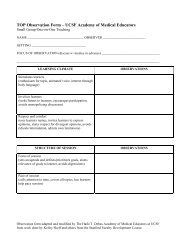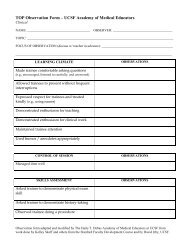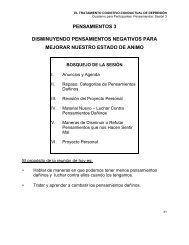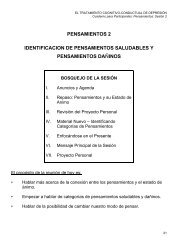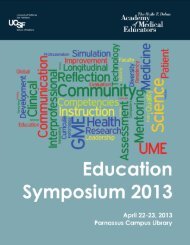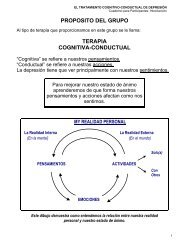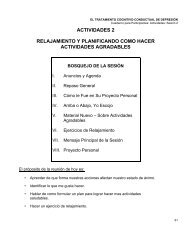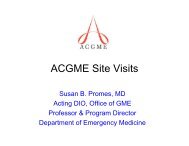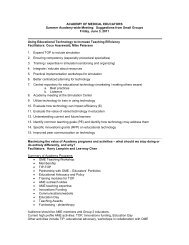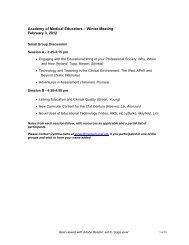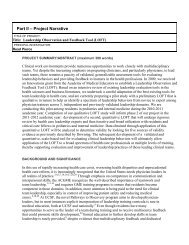2011 - UCSF School of Medicine - University of California, San ...
2011 - UCSF School of Medicine - University of California, San ...
2011 - UCSF School of Medicine - University of California, San ...
Create successful ePaper yourself
Turn your PDF publications into a flip-book with our unique Google optimized e-Paper software.
<strong>UCSF</strong> Education Day <strong>2011</strong>PISCES=4.32). Students in either longitudinal modelwere more likely to describe continuity relationships withpatients and preceptors/role models as strong positiveinfluences on their medical education. For 2008-2010,Model SFGH matched into Family <strong>Medicine</strong> at a higherrate than other students (18%vs6%).Discussion: Both the 6 month longitudinal and the 12-month longitudinal integrated model seem to <strong>of</strong>fer betterfeedback, positive continuity experiences, and morehighly-rated clerkship experiences than the traditionalmodel. However, longitudinal models are also moreresource-intensive. Any discussion <strong>of</strong> which model isoptimal should include consideration <strong>of</strong> outcomes as wellas resource use.Reflective critique: This work was discussed at STFM.Future research will focus on how to extend optimalaspects <strong>of</strong> the longitudinal models to students in all FMclerkship models.References:1. Hirsh, NEJM 2007.2. Irby, Academic <strong>Medicine</strong> 1995.3. Prislin, Academic <strong>Medicine</strong> 1998.Medical Student Perceptions <strong>of</strong>AnesthesiologyKathryn Price, MS, <strong>University</strong> <strong>of</strong> <strong>California</strong> <strong>San</strong>Francisco, <strong>School</strong> <strong>of</strong> <strong>Medicine</strong>, kathryn.price@ucsf.edu;Guneet Natt, MD, <strong>San</strong> Francisco VA Medical Center,guneet_nat@yahoo.com; Bridget O'Brien, PhD,<strong>University</strong> <strong>of</strong> <strong>California</strong> <strong>San</strong> Francisco, Office <strong>of</strong> MedicalEducation, ObrienB@medsch.ucsf.edu; MarekBrzezinski, MD PhD, <strong>University</strong> <strong>of</strong> <strong>California</strong> <strong>San</strong>Francisco, Department <strong>of</strong> Anesthesia and PerioperativeCare, BrzezinM@anesthesia.ucsf.edu; Martin Bogetz,MD, <strong>University</strong> <strong>of</strong> <strong>California</strong> <strong>San</strong> Francisco, Department<strong>of</strong> Anesthesia and Perioperative Care,BogetzM@anesthesia.ucsf.eduAreas abstract covers: UMEDomain(s) addressed: Pr<strong>of</strong>essionalism, ReflectionPurpose: To describe students’ perceptions <strong>of</strong>anesthesiology prior to their clinical clerkship.Background: Perceptions <strong>of</strong> another's field <strong>of</strong> practicecan impact interpr<strong>of</strong>essional collaborations. The hiddencurriculum may influence students' perceptions <strong>of</strong> a fieldand these perceptions may persist because studentslack opportunities to challenge them early in training.Inaccurate or negative perceptions may interfere withstudents’ openness to learning and interaction withpatients and team members.Methods: Medical students were asked to "describe onepreconceived notion about the specialty <strong>of</strong> anesthesia"at the start <strong>of</strong> their required <strong>UCSF</strong> anesthesiologyclerkship. Responses were collected from 1,009students from 2003 - 2009. A general inductive approachwas used to analyze students' written preconceptions.Preconceptions were coded with consensus by twoauthors for both theme and tone.Results: Five themes emerged: task responsibilities,patient interaction, lifestyle, reputation, and future <strong>of</strong> thefield. Task responsibilities were discussed mostfrequently(53%), <strong>of</strong>ten with negative tone(56%).Students felt "unclear" about the non-procedural taskresponsibilities <strong>of</strong> anesthesiologists. Patientinteraction(19%) was also perceived negatively(88%),with emphasis on lack <strong>of</strong> longitudinal relationships andlimited time spent with patients. Lifestyle-focusedpreconceptions(10%) were more positive(87%),centering on enviable hours and compensation. Higherlevels <strong>of</strong> substance abuse and difficulty interacting withsurgeons contributed to negative impressions(46%) <strong>of</strong>pr<strong>of</strong>essional reputation(16%). The future <strong>of</strong>anesthesiology(2%) was <strong>of</strong>ten viewed positively(60%),noted for job security and residency competitiveness.Discussion: Negative perceptions can adversely impactinterpr<strong>of</strong>essional respect, communication andcollaboration. Patient care and safety may suffer.Curricular interventions can facilitate more accurate,typically less critical perceptions <strong>of</strong> specialties. Earlierexposure through shadowing, preceptorships andinterest groups, especially during preclinical years, maydispel stereotypes, improving attitudes andunderstanding <strong>of</strong> anesthesiologyReflective critique: Presented and modified accordingto ESCape feedback.Medical Students’ Attention toMultiple Risk Behaviors: AStandardized Patient ExaminationJudith J. Prochaska, PhD, MPH, <strong>UCSF</strong> Department <strong>of</strong>Psychiatry, jprochaska@ucsf.edu; Kathleen Gali, <strong>UCSF</strong>Department <strong>of</strong> Psychiatry, Kathleen.Gali@ucsf.edu;Bernie Miller, <strong>UCSF</strong> Teaching and Learning Center,MillerB@medsch.ucsf.edu; Karen Hauer, MD, <strong>UCSF</strong>Department <strong>of</strong> <strong>Medicine</strong>, khauer@medicine.ucsf.eduAreas abstract covers: UMEDomain(s) addressed: Evaluation <strong>of</strong> Programs andCurricula, Research, Standardized Patients, Healthbehavior changePurpose: This study examined medical students’assessment and treatment <strong>of</strong> multiple risk behaviors in a36 The Haile T. Debas Academy <strong>of</strong> Medical Educators



